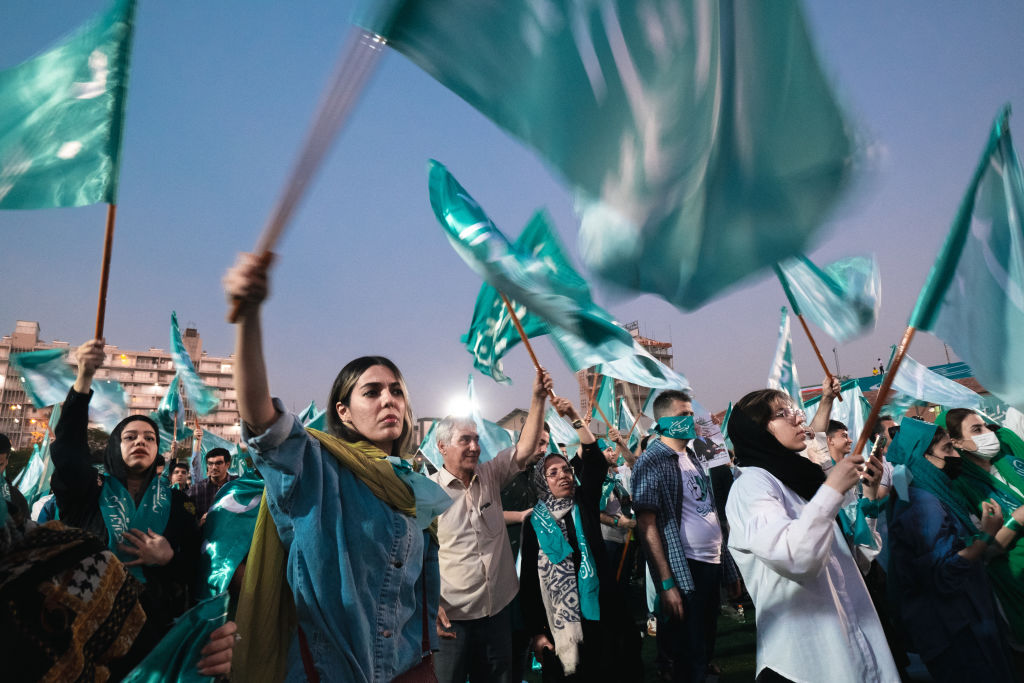Presidential elections in Iran offer a unique glimpse into the country’s fractious politics. On 5 July Iranians will head to the polls for the final round of the country’s current election cycle, where they’ll be choosing between two regime insiders whose minor ideological separation suddenly appears vast.
The surprising frontrunner, Masoud Pezeshkian, is running as a reformist and has been critical of the government’s enforcement of female Islamic dress codes as well as its aggressive foreign policy and online censorship drive. His opponent is Saeed Jalili, an unflinching hardliner, whose positions are closely aligned with those of the Supreme Leader, Ali Khamenei. Although at least 60% of eligible voters boycotted the first round of elections last week, the lowest turnout in the history of the Islamic Republic and a testament to the regime’s dwindling support, the contrast between the two candidates might inspire greater participation in the upcoming vote. Even if Jalili is the favourite given his proximity to the Supreme Leader, it’s entirely possible that the reformist dark horse could still prevail.
Yet, regardless of how the election goes, and however much Pezeshkian presents himself as a moderniser, Iran’s contentious policies are unlikely to change. It is the country’s unelected institutions that possess the real power. As Iran’s ruling theocrat, Khamenei sets the parameters of policy and alone has the authority to green-light or veto major decisions. The security forces — led by the Islamic Revolutionary Guards Corps (IRGC) — are also instrumental in decision-making, and have an outsized voice in foreign and strategic affairs. The president is left to manage the budget and represent the country on the international stage.
In that way, a president who advocates policies supported by the Supreme Leader and the IRGC can typically exercise more influence than one who seeks to alter the status quo. That favours the prospects of Jalili. Yet the president can use the Iranian public to disrupt the political order and add an element of unpredictability to each administration. Some past presidents, such as the reformist Mohammad Khatami and the hardliner Mahmoud Ahmadinejad, relied heavily on their ability to communicate directly with the Iranian people to advance their agendas and challenge the authority of the Supreme Leader.
That is what makes Pezeshkian a riskier candidate for the regime than Jalili, who would likely be a faithful steward of Khamenei’s will. Pezeshkian might be too but, because he’s already stated some reformist inclinations, his election could still reinvigorate populist appetites for change. Since 2018, Iran has witnessed a string of episodic protests, each more vehement than the last in their calls for a fundamentally new political system. More so than painting the regime in a good light, a reformist victory could revive those desires and inspire a new round of social upheaval, as seen after the murder in police custody of 22-year-old Mahsa Amini for insufficient Islamic dress. For his part, Pezeshkian called Amini’s arrest and death “unacceptable”.
So, what are the regime’s options? Assuming Khamenei and the IRGC prefer a continuity candidate, the most obvious solution would be to simply orchestrate a Jalili victory from behind the scenes. There is precedent for that: the elections that brought Ahmadinejad to office in 2005 and 2009 were both perceived to have been rigged. Yet, as we saw with the virulent protests that followed Ahmadinejad’s reelection in 2009, a fraudulent election can also trigger considerable backlash and protests. Assuming the regime wants to avoid a destabilising scenario, it might hesitate to engineer the election any further than it already has. But since Pezeshkian has been allowed to get this far, one suspects that the regime is comfortable with the prospect of his victory, or is unwilling to risk potential upheaval by denying him such.
Either way, Friday’s election promises to inject some tension into Iran’s otherwise stagnating political system. Even if the election is unlikely to change Iran’s behaviour abroad, or mollify its oppressive policies at home, it has already exposed cracks in the Islamic Republic’s foundation and undermined its claims of popularity. Khamenei has transformed Iran into a formidable regional power, but the edifice upon which his brutal theocracy resides is perhaps less sturdy than it appears. Whether Pezeshkian is the man to challenge that is not yet clear.











Join the discussion
Join like minded readers that support our journalism by becoming a paid subscriber
To join the discussion in the comments, become a paid subscriber.
Join like minded readers that support our journalism, read unlimited articles and enjoy other subscriber-only benefits.
Subscribe